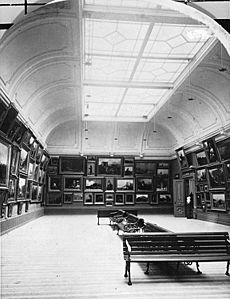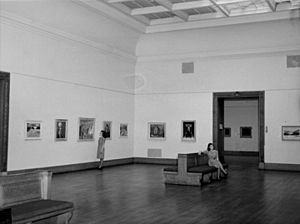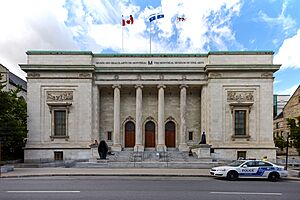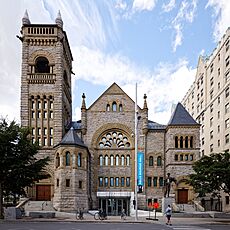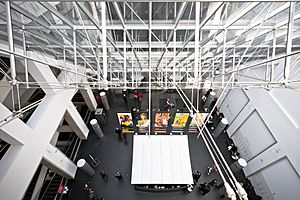Montreal Museum of Fine Arts facts for kids
| Musée des Beaux-Arts de Montréal | |
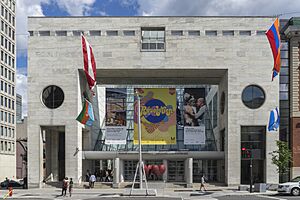 |
|
| Established | 23 April 1860 |
|---|---|
| Location | 1380 Sherbrooke West Montreal, Quebec H3G 1J5 |
| Type | Art museum |
| Visitors | 1.3 million (2017) |
| Public transit access | |
The Montreal Museum of Fine Arts (MMFA) is a famous art museum in Montreal, Quebec, Canada. It is the largest art museum in Canada when you look at how much space it has for showing art. You can find the museum on Sherbrooke Street West, in a historic area called the Golden Square Mile.
The MMFA has five different buildings, called pavilions. Together, they cover a huge area of 53,095 square metres (571,510 sq ft). About 13,000 square metres (140,000 sq ft) of this space is used for showing art. When the Michal and Renata Hornstein Pavilion for Peace opened in 2016, the museum became one of the biggest art museums in North America. In 2013, the museum's permanent collection had about 44,000 artworks. The museum also has the oldest art library in Canada.
The Montreal Museum of Fine Arts is part of a special group called the Bizot Group. This group allows leaders from the world's biggest museums to share artworks and exhibitions.
The museum was started in 1860, making it the oldest art museum in Canada. In 2020, it was the most visited art museum in Canada.
Contents
Museum's Story
How It Started
The museum began in April 1860 as the Art Association of Montreal. It was founded by Bishop Francis Fulford. The goal was to help people in the city learn to love and appreciate fine arts.
At first, the Art Association didn't have a permanent place. This meant they couldn't collect art or ask people to donate their artworks. For about 20 years, their shows and exhibitions were held in different places around Montreal.
In 1877, a Montreal businessman named Benaiah Gibb gave a wonderful gift. He donated 72 paintings and 4 bronze sculptures. He also gave the Art Association a piece of land on Phillips Square and $8,000. This money was for building a new museum on the land within three years.
On May 26, 1879, the Governor General of Canada, Sir John Douglas Sutherland Campbell, opened the Art Gallery of the Art Association of Montreal. This was the first building in Canadian history built just for an art collection. The Art Gallery at Phillips Square had an exhibition room, a smaller room for drawings, a lecture hall, and an early art school. The museum was made bigger in 1893. The Art Association held yearly shows for its members and a Spring Salon for Canadian artists.
Benaiah Gibb's gift was a very important moment for the museum's collection. His generous gift made the public very interested, and many more donations followed.
Moving to Sherbrooke Street West
The Art Association soon became too crowded at its first location. They decided to move from Phillips Square to the Golden Square Mile. This area was where many of the city's wealthy families lived. They chose the site of the old Holton House on Sherbrooke Street West for the new museum. Senator Robert Mackay, who owned the property, agreed to sell the house for a good price.
A committee was formed to oversee the building of the new museum. Many members of this committee, like James Ross, gave a lot of their own money for the construction. The old Phillips Square location was taken down in 1912. Today, an office tower with shops stands there.
The museum committee chose the design by brothers Edward Maxwell and William Sutherland Maxwell. They designed a grand and simple building. Construction started in the summer of 1910 and finished in the fall of 1912.
On December 9, 1912, the Governor General of Canada, Prince Arthur, Duke of Connaught and Strathearn, officially opened the new museum. About 3,000 people were there for the special event.
Modern Times
In 1949, the Art Association of Montreal changed its name to the Montreal Museum of Fine Arts. This new name better showed what the museum was all about.
By 1972, the MMFA became a semi-public institution. This meant it received most of its money from the government.
The museum expanded in the 1970s. In 1976, the Liliane and David M. Stewart Pavilion opened. This building has a modern design, made of concrete. It holds almost 900 decorative art and design objects. Most of these objects were given by Liliane and David M. Stewart, which is why the pavilion is named after them. The collection includes furniture, glass, silverware, textiles, and ceramics from different countries and times.
In the mid-1980s, the museum planned another big expansion. This led to the building of the Jean-Noël Desmarais Pavilion. In 1991, this third building opened on the south side of Sherbrooke Street. It was built with money from governments and businesses, especially the Desmarais family. The design of this building included the front of an old apartment-hotel that used to be on the site.
Art Thefts
On September 4, 1972, the museum experienced a major art theft. Thieves took jewelry, statues, and 18 paintings. These artworks were worth a lot of money at the time. The stolen paintings included works by famous artists like Delacroix, Gainsborough, and a rare Rembrandt landscape. One painting was returned, but the rest were never found. The people who took them were never identified.
In 2011, another theft happened. A visitor took a Roman marble head from its stand. Later that year, a Persian stone relief was also stolen in a similar way. These two artworks were valued at $1.3 million together.
In 2014, the Persian relief was found in Edmonton. The Roman head, however, is still missing.
Museum Buildings
The museum is made up of five main buildings, called pavilions:
- The Michal and Renata Hornstein Pavilion (built in 1912)
- The Jean-Noël Desmarais Pavilion (built in 1991)
- The Liliane and David M. Stewart Pavilion (built in 1976)
- The Claire and Marc Bourgie Pavilion (built in 2011)
- The Michal and Renata Hornstein Pavilion for Peace (opened in 2017)
Each pavilion focuses on different types of art. The Desmarais Pavilion shows modern and contemporary art. The Hornstein Pavilion focuses on ancient art and archaeology. The Liliane and David M. Stewart Pavilion is for decorative arts and design. The Claire and Marc Bourgie Pavilion displays Quebec and Canadian art. The newest Michal and Renata Hornstein Pavilion for Peace houses the international art collection.
In 2007, the museum announced plans to turn the old Erskine and American Church into a Canadian art pavilion. This church, built in 1893-1894, is a National Historic Site. It was named the Claire and Marc Bourgie Pavilion to thank the family for their big financial support. It opened in 2010.
With the addition of the fifth pavilion, the Montreal Museum of Fine Arts now covers 53,095 square metres (571,510 sq ft). About 13,000 square metres (140,000 sq ft) of this space is used for exhibitions. This expansion made it one of the largest art museums in North America.
| Pavilion | Size |
|---|---|
| Michal and Renata Hornstein Pavilion (1912) | 5,546 m2 (59,700 sq ft) |
| Liliane and David M. Stewart Pavilion (1976) | 9,610 m2 (103,400 sq ft) |
| Jean-Noël Desmarais Pavilion (1991) | 22,419 m2 (241,320 sq ft) |
| Claire and Marc Bourgie Pavilion (2011) | 5,460 m2 (58,800 sq ft) |
| Michal and Renata Hornstein Pavilion for Peace (2017) | 4,363 m2 (46,960 sq ft) |
| Sculpture Garden | 2,033 m2 (21,880 sq ft) |
| total: | 48,528 m2 (522,350 sq ft) |
Art Collection
The museum's art collection has grown a lot over the years thanks to many generous gifts. In 1892, John W. Tempest left 60 paintings and watercolors to the museum. He also left money to buy more European paintings. This money was the main way the museum bought European art until the 1950s.
In the late 1800s and early 1900s, many wealthy Montreal families had large art collections. Some of their family members later donated these artworks to the museum. Important families like the Drummond, Angus, Van Horne, and Hosmer families made big donations. In 1927, over 300 objects, including 150 paintings, were given by the family of Baron Strathcona and Mount Royal.
In 1917, the Art Association of Montreal started a department just for decorative arts. Frederick Cleveland Morgan volunteered to be the curator of this collection. He added more than 7,000 pieces to the museum's collection through purchases and donations. He also helped the museum become an "encyclopedic museum," meaning it would collect all kinds of art, not just fine arts.
Since 1955, the museum has received funds from the Horsley and Annie Townsend legacy. This money helps the museum buy Canadian and international artworks. Many other people have also given gifts and donations. For example, in 1959, Joseph Arthur Simard gave a collection of 3,000 Japanese incense boxes. These boxes once belonged to the French leader Georges Clemenceau.
In 1960, the museum celebrated its 100th birthday. They published a catalog of selected artworks and a museum guide.
Major contributions have also come from Renata and Michal Hornstein since the 1970s. These include works by Old Masters and a large collection of drawings by the Swiss painter Ferdinand Hodler.
These gifts have greatly expanded the museum's collections. In 2000, the museum received a huge collection of modern design objects. These were collected by Liliane M. Stewart and David M. Stewart. Liliane M. Stewart donated over 5,000 objects to the museum's collection.
Museum Connections
The museum works with other organizations like the Canadian Museums Association, the Canadian Heritage Information Network, and the Virtual Museum of Canada.
More to Explore
- Culture of Montreal
- List of art museums
- List of largest art museums
- List of museums in Montreal
See also
 In Spanish: Museo de Bellas Artes de Montreal para niños
In Spanish: Museo de Bellas Artes de Montreal para niños


